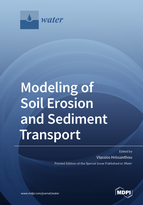Modeling of Soil Erosion and Sediment Transport
A special issue of Water (ISSN 2073-4441). This special issue belongs to the section "Water Erosion and Sediment Transport".
Deadline for manuscript submissions: closed (14 December 2019) | Viewed by 54859
Special Issue Editor
Interests: rainfall-runoff; soil erosion; sediment transport; reservoir sedimentation
Special Issues, Collections and Topics in MDPI journals
Special Issue Information
Dear Colleagues,
The planned Special Issue will focus on the mathematical modeling of soil erosion caused by rainfall and runoff at a basin scale, as well as on the sediment transport in the streams of the basin. In concrete terms, the quantification of these phenomena by means of mathematical modeling and field measurements will be studied. Soil erosion products are transported by runoff into the streams of a basin and through the streams to the basin outlet, which may also be the inlet of a natural or artificial lake. Transport of large amounts of suspended sediment in the streams is mainly due to the frequency and intensity of rainfall events. Mud floods resulting from intense rainfalls of long duration are routed through the streams and have catastrophic consequences for both rural and urban settlements. The removal of fertile soil and the acceleration of reservoir sedimentation are some additional unfavourable sequels of soil erosion. Finally, soil erosion modeling informs actions against soil erosion.
Emer. Prof. Vlassios Hrissanthou
Guest Editor
Manuscript Submission Information
Manuscripts should be submitted online at www.mdpi.com by registering and logging in to this website. Once you are registered, click here to go to the submission form. Manuscripts can be submitted until the deadline. All submissions that pass pre-check are peer-reviewed. Accepted papers will be published continuously in the journal (as soon as accepted) and will be listed together on the special issue website. Research articles, review articles as well as short communications are invited. For planned papers, a title and short abstract (about 100 words) can be sent to the Editorial Office for announcement on this website.
Submitted manuscripts should not have been published previously, nor be under consideration for publication elsewhere (except conference proceedings papers). All manuscripts are thoroughly refereed through a single-blind peer-review process. A guide for authors and other relevant information for submission of manuscripts is available on the Instructions for Authors page. Water is an international peer-reviewed open access semimonthly journal published by MDPI.
Please visit the Instructions for Authors page before submitting a manuscript. The Article Processing Charge (APC) for publication in this open access journal is 2600 CHF (Swiss Francs). Submitted papers should be well formatted and use good English. Authors may use MDPI's English editing service prior to publication or during author revisions.
Keywords
- soil erosion
- deposition
- rill erosion
- interrill erosion
- gully erosion
- landslide erosion
- streambed erosion
- sediment transport
- mathematical modeling
- field measurements
- rainfall-runoff
- overland flow
- streamflow






